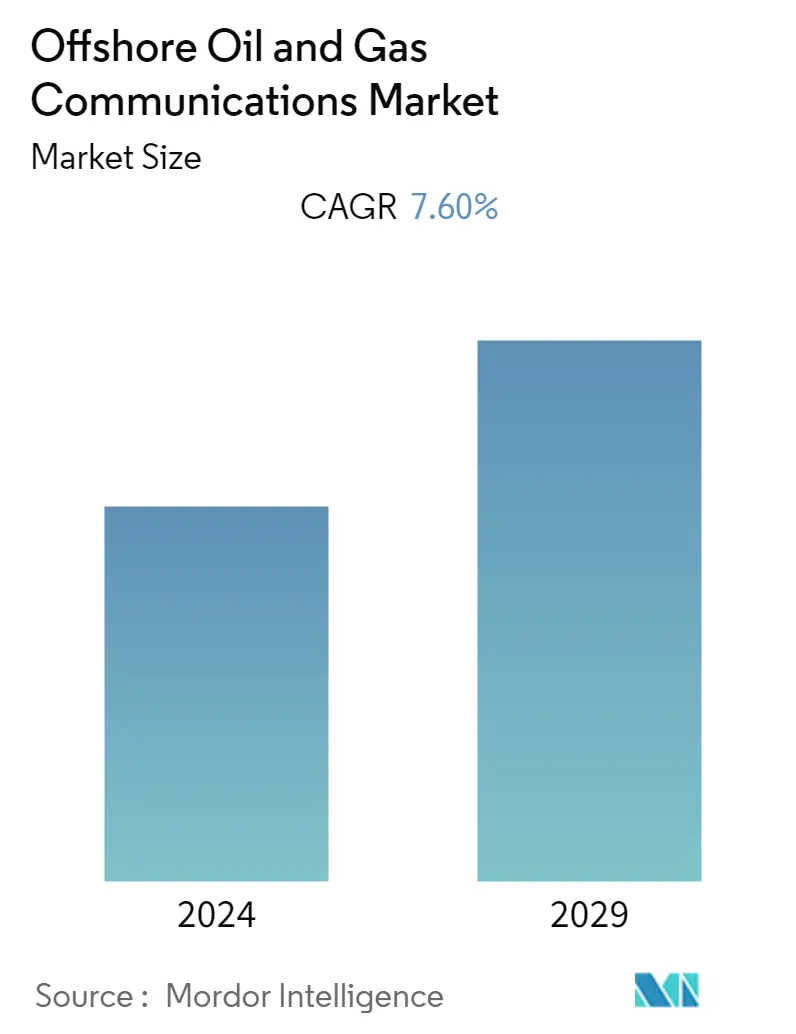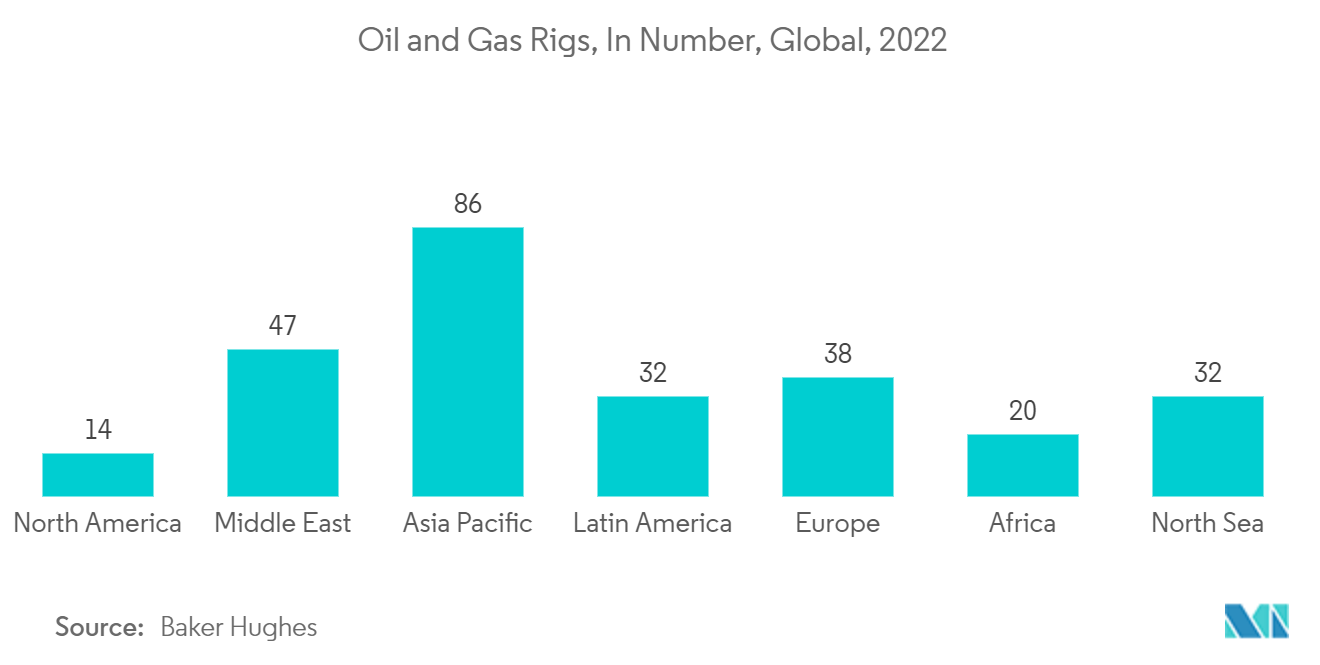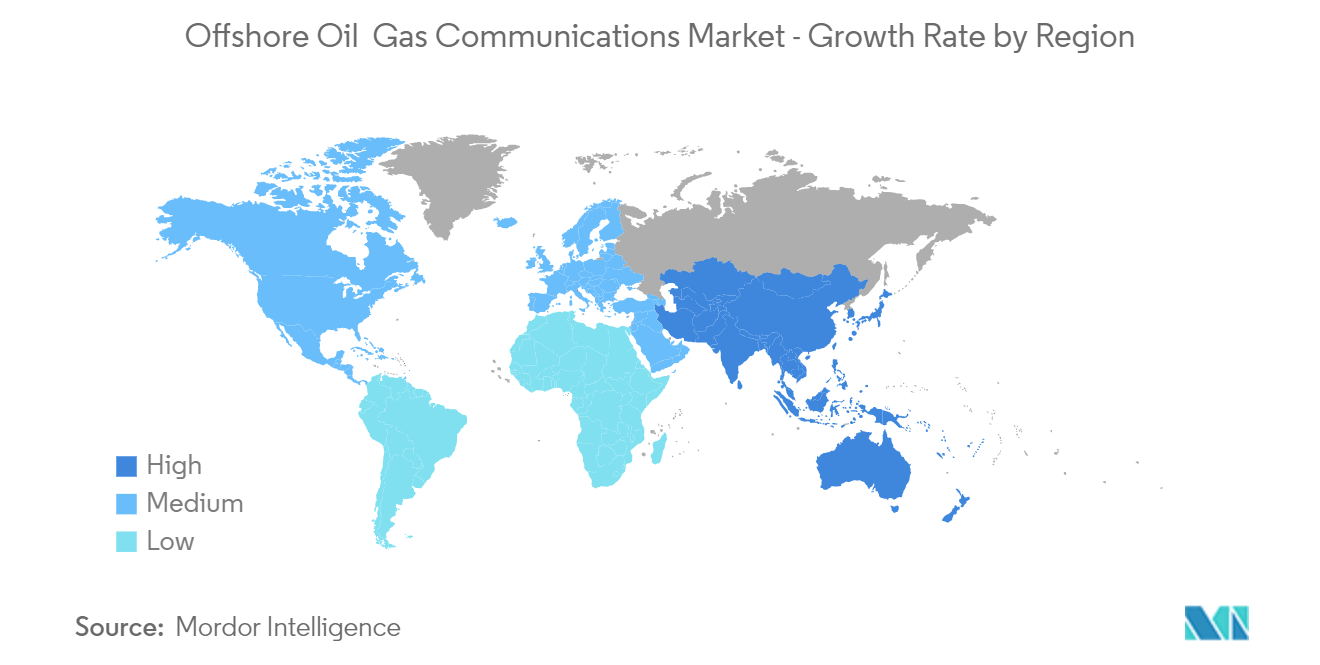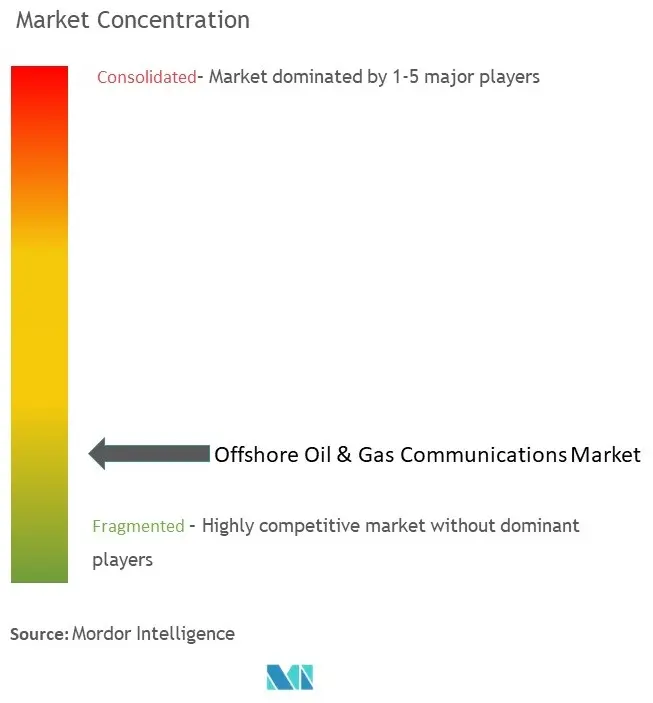Offshore Oil and Gas Communications Market Size

| Study Period | 2019 - 2029 |
| Base Year For Estimation | 2023 |
| CAGR | 7.60 % |
| Fastest Growing Market | Asia-Pacific |
| Largest Market | North America |
| Market Concentration | Medium |
Major Players
*Disclaimer: Major Players sorted in no particular order |
Offshore Oil and Gas Communications Market Analysis
During the time frame of the forecast, the offshore oil and gas communications market is anticipated to register a CAGR of 7.6%.During the forecast period, the market is expected to grow because the oil and gas industry is investing more in new technologies and digital technologies.
- From the oil rig to the offshore platforms, it's important to have good oil and gas communication equipment for safety and efficiency. A good communication system does more than just send data between businesses that are offshore and those that are onshore.
- Offshore rigs are comparatively hard to establish, operate, and maintain. They must deal with environmental factors, including strong ocean currents and highly remote environments. Most of them are deep-water rigs that operate at great depths. In such remote locations, communications play a major role in monitoring several components and staying in contact with onshore establishments for reporting and assistance in emergencies.
- Several different communication technologies can now work alone or as a system to solve communication problems offshore. Satellite communications, which require a VSAT at the offshore site and are used by ships in remote places or that are moving, are the most common way to talk to people while offshore. Cellular networks are now being used in offshore oil fields because more money is being put into infrastructure there.
- Still, the offshore oil and gas field communications industry will be slowed down by worries about not enough data protection, risks in data transfer, asset security, and the difficulty of cyberattacks. Oil price volatility would even further slow the oil field communications sector's growth. The high expenses of maintaining this procedure will further limit the expansion of the oil field communications business.
- COVID-19 had an impact on the oil and gas industry as well. Everyone has had to adjust, from people being placed on leave to businesses having to radically rethink their long-term plans. Businesses must rethink their long-term strategies. When it comes to offshore oil rigs, the effect is more evident. The COVID-19 pandemic hindered offshore oil rig development and maintenance. Post-epidemic, the industry is expanding as it adopts new technology and new working methods, with companies adjusting to these new circumstances.
Offshore Oil and Gas Communications Market Trends
This section covers the major market trends shaping the Offshore Oil & Gas Communications Market according to our research experts:
Telecom-based Technological Advancements to Drive the Market Growth
- A few years ago, communications between offshore facilities and onshore locations were limited to a two-way radio channel and daily reports. Oilfield workers stationed offshore were virtually cut off from the rest of the world. However, with the technological advancements in communication technologies, offshore industry work has been transformed.
- With the help of microwave communications technology, data is sent over wavelengths that are less than one meter long.These microwave solutions are chosen for locations that are close to each other. Fiber-optic telecommunications are chosen for locations in high-traffic areas, such as the North Sea or the US Gulf of Mexico.
- Technological advancements have allowed improved communication systems that have transformed total subsea developments and the way the remote, unmanned offshore industry works. The increasing vulnerability to cyber security threats in the oil and gas sector is a significant growth driver for the oil field communications market. The growing need for cloud-based services and a greater emphasis on adopting effective communication technology will exacerbate the demand for oil field communications. Increasing investments in network infrastructure and the expansion and growth of the oil and gas sector will generate more profitable growth prospects for the oil field communications market.
- With more oil and gas projects being built around the world, the offshore oil and gas communications market is expected to grow. Baker Hughes says that as of last year, Asia Pacific had the most offshore oil and gas rigs.

North America is Expected to Hold the Largest Market Share
- One of the biggest markets for offshore oil and gas communications is North America.The demand for communication equipment in this area is likely to be driven by the discovery of new shale resources in the United States and the growth of oil and gas projects in Canada.
- This region is said to be the pioneer in this market because it is also the largest oil and gas producer. According to Baker Hughes, North America hosts the most oil and gas rigs globally and has 14 offshore oil and gas rigs. Moreover, the market is expected to grow, with companies seeking advanced digital solutions for offshore field operations.
- Globally increasing crude oil prices that are expected to reach pre-crisis levels over the forecast period are expected to increase upstream oil and gas activity, leading to an increase in demand for offshore communications in the oil and gas industry.
- During the time frame of the projection, the market would grow because more advanced technologies would be used, there would be more demand for these technologies in large oilfields and offshore locations, and oil and gas field excavation activities in the region would grow quickly.

Offshore Oil and Gas Communications Industry Overview
There are a few big players in the offshore oil and gas communications market, such as ABB Ltd., Alcatel Lucent SA, Baker Hughes Incorporated, CommScope Inc., and AT&T Inc.Players in the market are using partnerships, mergers, investments, and acquisitions to improve their products and gain a competitive edge that will last.
In July 2022, Baker Hughes announced that it was buying AccessESP, which was one of the leading providers of advanced technology for artificial lift solutions. This was done to modernize oil and gas operations by lowering operating costs and downtime, which would make them much more efficient.AccessESP's "GoRigless ESP System" has its own solutions that make it possible to set up and take down an electrical submersible pump (ESP) with standard, light-duty intervention equipment (like a wireline, coiled tubing, or well tractor) instead of a rig or pulling well production tubing.These solutions greatly reduce the cost and downtime of ESP replacement workovers, which are becoming more important in offshore and isolated settings.
Alcatel-Lucent Enterprise, one of the top providers of communications, cloud, and networking solutions for specific industries, announced Purple on Demand in November 2022. Purple on Demand is a new commercial product that is sold on a subscription basis and focuses on offering secure business communications to end users in a private setting. Businesses that start on a digital transition seek simplicity, flexibility, security, and digital sovereignty. Purple on Demand provides business communication services, including software available through a subscription model and gear, such as phone sets, conferencing devices, and peripherals, to satisfy these demands.
Offshore Oil and Gas Communications Market Leaders
-
ABB Ltd
-
Alcatel Lucent SA
-
Baker Hughes Incorporated
-
CommScope Inc.
-
AT&T Inc.
*Disclaimer: Major Players sorted in no particular order

Offshore Oil and Gas Communications Market News
- December 2022: DeepOcean and Akvaplan-Niva partnered on the prospective use of remotely operated vehicles (ROVs) and unmanned glider vehicles (USVs) to conduct environmental assessments for offshore wind and oil and gas installations.
- May 2022: Ericsson and Tampnet partnered to deliver IoT connection management to the offshore industry. With Ericsson IoT Accelerator's management capabilities, modern sensors and remote monitoring equipment can be deployed to people and places in various remote offshore use cases and connected in real time.
Offshore Oil and Gas Communications Market Report - Table of Contents
1. INTRODUCTION
- 1.1 Study Assumption and Market Definition
- 1.2 Scope of the Study
2. RESEARCH METHODOLOGY
3. EXECUTIVE SUMMARY
4. MARKET INSIGHTS
- 4.1 Market Overview
-
4.2 Industry Attractiveness - Porter's Five Forces Analysis
- 4.2.1 Threat of New Entrants
- 4.2.2 Bargaining Power of Buyers/Consumers
- 4.2.3 Bargaining Power of Suppliers
- 4.2.4 Threat of Substitute Products
- 4.2.5 Intensity of Competitive Rivalry
- 4.3 Industry Value Chain Analysis
- 4.4 Impact of COVID-19 on the Market
5. MARKET DYNAMICS
-
5.1 Market Drivers
- 5.1.1 Increase in Demand for Offshore Oilfield Communication Solutions
- 5.1.2 Telecom-based Technological Growth
-
5.2 Market Restraints
- 5.2.1 Risk in Data Transfer
6. MARKET SEGMENTATION
-
6.1 By Solution
- 6.1.1 Upstream Communication Systems
- 6.1.2 Midstream Communication Systems
- 6.1.3 Downstream Communication Systems
-
6.2 By Communication Network Technology
- 6.2.1 Cellular Communication Network
- 6.2.2 VSAT Communication Network
- 6.2.3 Fiber Optic-based Communication Network
- 6.2.4 Microwave Communication Network
-
6.3 By Geography
- 6.3.1 North America
- 6.3.2 Europe
- 6.3.3 Asia-Pacific
- 6.3.4 Latin America
- 6.3.5 Middle East & Africa
7. COMPETITIVE LANDSCAPE
-
7.1 Company Profiles
- 7.1.1 ABB Ltd
- 7.1.2 Alcatel Lucent SA
- 7.1.3 Baker Hughes Incorporated
- 7.1.4 CommScope Inc.
- 7.1.5 AT&T Inc.
- 7.1.6 Redline Communications Inc.
- 7.1.7 Harris CapRock Communications Inc.
- 7.1.8 Hughes Network Systems LLC
- 7.1.9 Huawei Technologies Co. Ltd.
- 7.1.10 Siemens AG
- *List Not Exhaustive
8. INVESTMENT ANALYSIS
9. MARKET OPPORTUNITIES AND FUTURE TRENDS
** Subject To AvailablityOffshore Oil and Gas Communications Industry Segmentation
Oil and gas communications systems provide critical voice and data services both locally on the various offshore assets used-such as drilling rigs and production platforms-and between the offshore sites and their onshore control centers.
Offshore communications in the oil and gas industry have come a long way. Now, real-time communications networks not only enable wi-fi connectivity and personal cell phone connections but also real-time data transfer from offshore to onshore offices located around the world.
The offshore oil and gas communications market is segmented by solution (upstream communication systems, midstream communication systems, and downstream communication systems), by communication network technology (cellular communication network, VSAT communication network, and fiber optic-based communication network), and by geography (North America, Europe, Asia Pacific, the Middle East, and Africa).
The market sizes and forecasts are provided in terms of value (in USD million) for all the above segments.
| By Solution | Upstream Communication Systems |
| Midstream Communication Systems | |
| Downstream Communication Systems | |
| By Communication Network Technology | Cellular Communication Network |
| VSAT Communication Network | |
| Fiber Optic-based Communication Network | |
| Microwave Communication Network | |
| By Geography | North America |
| Europe | |
| Asia-Pacific | |
| Latin America | |
| Middle East & Africa |
Offshore Oil and Gas Communications Market Research FAQs
What is the current Offshore Oil & Gas Communications Market size?
The Offshore Oil & Gas Communications Market is projected to register a CAGR of 7.60% during the forecast period (2024-2029)
Who are the key players in Offshore Oil & Gas Communications Market?
ABB Ltd, Alcatel Lucent SA, Baker Hughes Incorporated, CommScope Inc. and AT&T Inc. are the major companies operating in the Offshore Oil & Gas Communications Market.
Which is the fastest growing region in Offshore Oil & Gas Communications Market?
Asia-Pacific is estimated to grow at the highest CAGR over the forecast period (2024-2029).
Which region has the biggest share in Offshore Oil & Gas Communications Market?
In 2024, the North America accounts for the largest market share in Offshore Oil & Gas Communications Market.
What years does this Offshore Oil & Gas Communications Market cover?
The report covers the Offshore Oil & Gas Communications Market historical market size for years: 2019, 2020, 2021, 2022 and 2023. The report also forecasts the Offshore Oil & Gas Communications Market size for years: 2024, 2025, 2026, 2027, 2028 and 2029.
Offshore Oil and Gas Communications Industry Report
Statistics for the 2023 Offshore Oil and Gas Communications market share, size and revenue growth rate, created by Mordor Intelligence™ Industry Reports. Offshore Oil and Gas Communications analysis includes a market forecast outlook to 2029 and historical overview. Get a sample of this industry analysis as a free report PDF download.



